America’s Great Divergence
CONNERSVILLE, Indiana—Ashley Gabbert and Dan Dark are both white Indiana residents in their early 30s, but their lives look nothing alike.
Gabbert, 32, lives in this town in one of the poorest counties in Indiana, where she works the night shift—10 p.m. to 6:30 a.m.—for an automotive parts manufacturer. Her life now is a step up from the decade she spent working in fast food, which wasn’t “much of a career,” she told me at the local Walmart, where she was shopping for groceries. Working in fast food, she’d frequently encounter drug users as they pulled up to the drive-in window, needles alongside babies in the backseat of their cars. Like 80 percent of people in rural America, Gabbert doesn’t have a bachelor’s degree.
Dark, 33, lives in the increasingly metropolitan city of Indianapolis, where he runs a creative consultancy doing videos and marketing work for a variety of clients. Dark, who is a college graduate, works when he chooses, often from his downtown home or from the coffee shops and bars springing up around downtown Indianapolis. He loves to travel—he recently returned from Iceland—and goes out to meet friends almost every night of the week. The same night Ashley Gabbert was prepping for her night shift by dropping her 11-year-old daughter off with her mother, Dark was cooking a venison stew for a meat-and-bourbon potluck dinner thrown by a friend. “I’ve built my life around flexibility,” he told me.
In some ways, the lives of Gabbert and Dark represent the diverging fates of two parts of America in the past two decades. Half a century ago, economic opportunity and upward mobility were available to many white Americans, regardless of where they lived and what kind of education they had. They could graduate from high school and find a job at a local factory and make a good wage, or graduate from college and sit behind a desk and make a slightly better wage. About 90 percent of kids born in the 1940s earned more than their parents did, according to work by Stanford economist Raj Chetty. But beginning in the 1980s, the returns on a college education started growing, and more of the benefits of economic growth started accruing to only those with an education, as those without an education saw their opportunities shrink. People with a college degree or more now earn 50 percent of aggregate U.S. household income, up from 37 percent in 1991, while people with less than a high school degree now earn 5 percent, down from 12 percent in 1991, according to Census data. (1991 is the earliest year for which there is comparable data.)
This divergence in fortunes for those with and without higher education has coincided with another divergence—that between America’s growing cities and its struggling rural regions. For a century leading up to 1980, poorer regions were catching up to richer regions of the country in terms of wages, as an oversupply of workers in richer regions drove wages down, while an undersupply in poorer regions drove wages up. But this “convergence,” as economists call it, petered out with the rise of computers, according to research by the University of Chicago doctoral candidate Elisa Giannone. Beginning in the 1980s, as computers made certain people more productive and valuable in the labor market and made other people obsolete, wealthy regions with educated workers began to do better and better. Between 1940 and 1980, wages in poorer U.S. areas grew faster than wages in richer places by 1.4 percent per year. But starting in the 1980s, wages in poorer places stopped catching up to those in richer ones, Giannone says.
“What’s happened to Connersville is that the jobs came out and heroin came in.”
Today, people with a college degree are more likely than they used to be to move to metropolitan regions with good jobs and other people like them, and this means both that those regions do better over time and that the return on that education is even greater. Almost half of college graduates move out of their birth states by age 30, according to Enrico Moretti, an economist at Berkeley. Only 27 percent of high school graduates do. As booming cities draw in new college-educated workers, employers seeking these workers follow, and cities continue to gain strength like magnets. This improves the prospects of everyone in the region, including those without college degrees. The working-class strongholds that once prospered without college-educated workers, on the other hand, are doing worse and worse, as computers and robots replace the workers whose jobs haven’t been sent overseas, and, as a result, an oversupply of labor brings down wages for everyone still there.
What this means is that people like Dan Dark and Ashley Gabbert are having increasingly different experiences of America. “What has been striking over the past two decades is how different the winners are becoming from the losers,” said Moretti, who has studied this phenomenon, which he calls the Great Divergence. “The wage gap, the human capital gap, the gap in type of employers, have been growing at a fast pace.”
Recommended: Trump’s 'Two-for-One' Regulation Executive Order
* * *
A few decades ago, Ashley Gabbert’s hometown of Connersville was a manufacturing powerhouse. Known as “Little Detroit” for the volume of cars and automotive parts it produced, it was a key link in the Midwest’s automotive supply chain, and was at one time the world’s top producer of dishwashers. At its peak in 1980, Fayette County, of which Connersville is the county seat, had around 28,000 people and 12,000 manufacturing jobs.
Connersville today is a small hamlet of single-family homes interspersed with boarded-up buildings, fast-food restaurants, and low-cost chains like Family Dollar. Fayette County’s population is now 18 percent smaller than it was in 1980. Its unemployment rate is 6.1 percent, one of the highest rates in the state of Indiana. Its residents report higher numbers of poor mental health days than residents in other parts of the state, and they have among the shortest life expectancies. Like many of Indiana’s more rural regions, Fayette County is facing a growing opioid epidemic. “What’s happened to Connersville is that the jobs came out and heroin came in,” Ron Corbin, a longtime resident, told me.
This decline began in the 1980s, Dan Parker, the executive director of the Economic Development Group of Connersville and Fayette County, told me, as big manufacturers started to downsize or move overseas. The last big employer, the auto parts supplier Visteon, laid off its remaining 890 employees in 2007. That closure and the ones before it had a ripple effect on other businesses like gas stations and dry cleaners, as people in the community were thrust out of work. “A lot of the mom-and-pop shops just evaporated when those corporations folded,” Parker told me.
Recommended: How to Build an Autocracy
As big employers left, it became increasingly difficult for people to do better than their parents did—economists’ go-to measure of economic mobility. Ashley Gabbert’s mother worked at the Visteon plant, making radiators, until she got laid off when the plant closed. But Gabbert has fewer options than her mother did: There are only two manufacturing companies left in Connersville, and because there are so many more workers available relative to the number of jobs, they can pay less than the big companies once did. Gabbert was lucky to find a job in manufacturing at all; Justin Williams, 24, is working at a bar where he depends on tips. He’s also had stints at a call center in town, which paid $9 an hour, and at a restaurant that closed down because of lack of business. His mother worked for the Visteon plant, where she made $25 an hour. “The money is different nowadays,” he said.
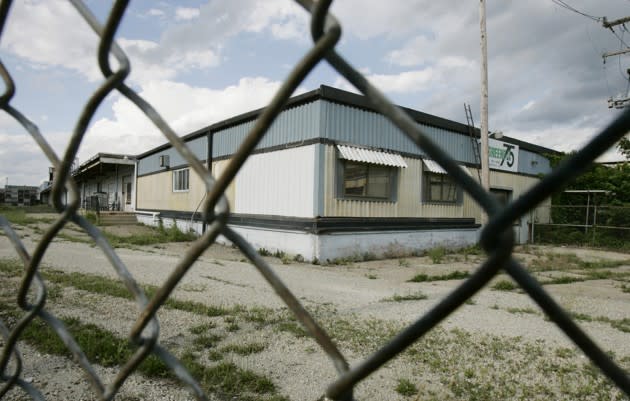
There are, of course, many people in Connersville who are doing just fine, and who wouldn’t leave for a more dynamic area even if given the chance. I talked to a man named Clay Smith, 30, who has been a lineman for an electric company for nine years. He loves his job, gets paid well, owns his own home, and spends his weekends outdoors. He didn’t go to college, and is doing just fine.
Recommended: How to Respond to Donald Trump's Betrayal of American Values
But Smith’s situation is a rare one; increasingly, skipping college leads to low earnings and few opportunities. About 22 percent of Millennials with only a high school diploma live in poverty, compared to six percent of college graduates. This is a change from their parents generation: When the early Baby Boomers were in their 20s and 30s in 1979, just seven percent of people with only a high school degree lived in poverty, according to the Pew Research Center.
Most people like Smith who do not get an education beyond high school stay put. By contrast, when people do get a college degree, they often head for the cities. In Fayette County, only six percent of residents over the age of 25 have a bachelor’s degree.
“One of Fayette’s challenges is when parents work hard and do the right thing and send their kids off to college, most of them don't come back,” Drew Klacik, a senior policy analyst at Indiana University’s Public Policy Institute, said.
People who have the resources to leave depressed American towns tend to do so. Ron Corbin, 39, is an example of this. He wanted to stay in Connersville, where he was born and raised. He has taken a handful of college classes, though he does not have a degree, and for a few years, lived in Connersville and did freelance video production from there. But as the town got more and more depressed, he decided he didn’t want to raise his children there. “Once-nice neighborhoods have turned into Section 8 hubs,” Corbin told me. “People are just stuck in despair.” Recently, when he was taking his 8-year-old son to school, Corbin saw an addict overdose. It was the last straw; he decided leave Connersville and move to a suburb of Indianapolis.
People from all across Indiana, are, like Corbin, ending up in and around cities such as Indianapolis and university towns like Bloomington and Lafayette. As some areas of the state shrink, the population of the Indianapolis-Carmel-Anderson metropolitan area has grown 14 percent since 2000. About 20 percent of people in the region have a bachelor’s degree, up from 16.8 percent in 2000. The 10-county metropolitan area around Indianapolis now has 27 percent of the state’s population, up from 25 percent in 2000. Other large metropolitan areas grew between 2000 and 2010, while mid-sized communities shrank. Connersville lost 5 percent of its population between 2000 and 2010. “In general, the metropolitan areas are showing population growth, income growth, increased educational attainment, and the rural areas either are holding their own or actually getting slightly older and experiencing slower income growth,” Klacik, of Indiana University, said.
Many of the jobs being created in Indianapolis are high-paying ones in sectors like tech or medicine. The biggest employment sector is professional and technical services, in which employees make an average of $73,000, according to Indy Chamber, the regional chamber of commerce. That sector includes companies like SalesForce, which bought the Indianapolis start-up ExactTarget in 2013, and has been expanding since then. Other big employers include the pharmaceutical giant Eli Lilly, and the online consumer-ratings company Angie’s List, both of which employ large numbers of college-educated people.
These companies are an example of the growing piece of the American economy that is focused on innovation and knowledge, rather than on producing physical goods. After all, companies that solely produce physical goods can send those jobs overseas or automate them. But that’s harder to do for companies that rely on highly-skilled workers to create new ideas and customized goods (for now, at least).
“There’s growing demand for people who have the skills to handle the technological improvements that have taken place over the past 30 years,” Moretti told me. “There’s less and less demand for workers who are doing traditional manufacturing production.”
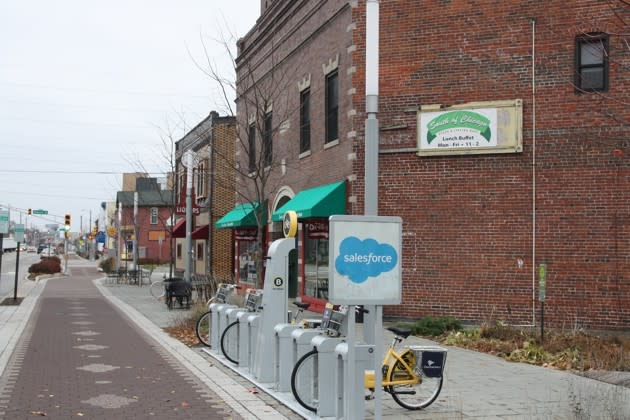
In some ways, the divergence between places like Connersville and Indianapolis is a tale of the Americans who are benefiting from globalization and those who are getting crushed by it. Educated workers in cities produce work that requires innovation and new ideas, work that isn’t easily replicated and can’t be outsourced. Less educated workers in struggling regions are competing with people and machines around the globe, and their wages are the worse for it.
But the divergence is more than just between workers who benefit from globalization and those that don’t. It’s also between the places those two groups tend to live. That’s because of something that economists refer to as the agglomeration economy. Basically, it means that companies want to locate near other innovative companies so that they can find skilled and specialized workers, which in turn makes those companies even more productive. They want to be places where the job market is full of educated workers who they can hire. They want to be near the specialized services, like venture capitalists or bankers, who can help make their companies even better or provide funding. And they want to benefit from what Moretti calls a “knowledge spillover,” in which people at certain types of companies learn from innovations created at other companies near them, through professional and social networks.
This concentration of good jobs in a few hubs creates more opportunity for everyone, not just people with college degrees. Innovation workers can command higher salaries than people in other industries such as manufacturing do. With their money they eat out more, go shopping, spend on entertainment, and pay for services like dry cleaning, house cleaning, and childcare. All of this spending creates more jobs. Moretti has analyzed 11 million workers in 320 metropolitan areas, and found that every new high-tech job in a metropolitan area creates five additional local jobs. Every new manufacturing job creates just 1.6 additional local jobs. “A city that has a lot of college grads also tends to have a different economic ecosystem,” Moretti told me. Yet such cities are cost prohibitive for many of the lower-skilled people who might want to locate there. In Indianapolis, for instance, housing prices have surged as more people have moved there, pricing many families out. Moving to booming cities is both a solution for low-skilled people, then, and an impossibility.
* * *
This economic divergence has political implications. As the economist Jed Kolko noted after the election, Trump fared best in the types of places like Connersville, where jobs are vulnerable to outsourcing or automation. He also performed well among voters without a college degree, and in places where full-time employees don’t earn very much.
Democrats, on the other hand, are increasingly finding their support concentrated in urban areas (with the exception of a few rural counties mostly in the northeast and Hawaii). As my colleague Ronald Brownstein has noted, Hillary Clinton did best in big urban areas, winning 88 out of the nation’s largest 100 counties. Clinton “utterly routed Trump in thriving new economy centers like Austin, Silicon Valley, and Seattle,” he wrote. Nearly 60 percent of people in Marion County, where Indianapolis is located, voted for Hillary Clinton. And 72 percent of people in Fayette County, where Connersville is located, voted for Trump.
Perhaps more importantly, as college-educated people cluster in cities, they have less and less exposure to people in places like Connersville. And people in Connersville have less exposure to educated people like those who live in Indianapolis.
“I guess I surround myself with like-minded people,” Elle Roberts, a 28-year-old African American social activist who lives in Indianapolis, told me at a local wine bar. “People closest to me tend to be liberal, and we tend to congregate in urban areas.” Roberts, a graduate of Purdue University, moved to Indianapolis from a mid-sized town in northwest Indiana. I went with her to a poetry slam in the basement of a club in Indianapolis on a cold night where dozens of people, mostly minorities, were hanging out.
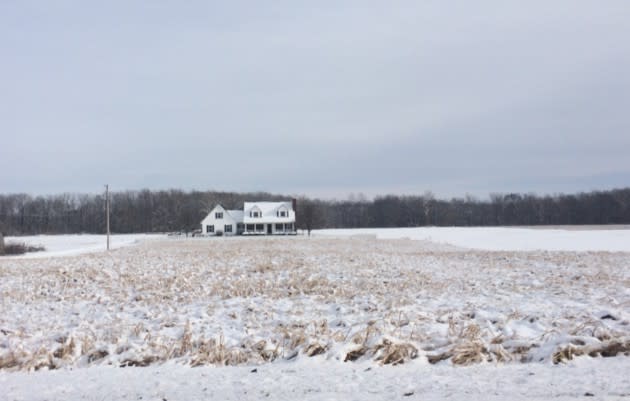
Connersville exists quite separately from this world. (One Connersville resident, Brendon Friend, 22, told me he liked the area because “there aren’t many black people here.”) In the small town, there are two places people go for entertainment at night: Mousie’s, a bar and restaurant that serves dollar drafts and and cheap wings on Mondays, and Pizza King, a family restaurant where teenagers congregate. Most of the people I met in Connersville told me they spent their leisure time either with family or outdoors; hiking, hunting, fishing, riding four-wheelers. Almost everybody I talked to owns their own house and car and had children young. “It’s just easy to live here,” Clay Smith told me “Everybody knows everybody.”
This is the type of self-sorting that journalist Bill Bishop illustrated his book, The Big Sort, in which he showed how Americans are increasingly choosing to live near other people like them. As he points out, the number of landslide counties, in which a candidate won by 20 percentage points or more, has skyrocketed since the 1970s. This “ideological segregation,” as Bishop calls it, also means that people who have different political beliefs are less and less likely to understand each other. People who are surrounded by others with similar beliefs and life experience are more susceptible to processing news through a biased lens, as I’ve written before. The more segregated America becomes by education level, the more the political beliefs of its two sides will diverge.
As the rural-urban split increases, the two types of regions are battling each other on state policies such as minimum-wage hikes and local civil-rights protection laws. Indiana has had many such conflicts; after Indiana passed a “religious freedom” act, the Indianapolis city-county council passed its own resolution rejecting the act. The Indianapolis-based Angie’s List canceled a planned $40 million expansion over the religious freedom act, with its founder saying he feared his young employees would look for work in other places “that don’t have this tone.”
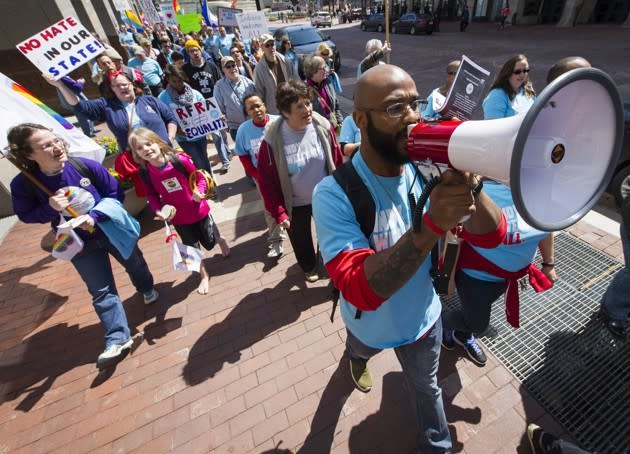
In some ways, people in Indianapolis are becoming more similar to other city-dwellers all over the country, and the lives of those in small towns everywhere are looking increasingly similar. People in small towns live near their families, in fairly homogeneous settings; people in cities live farther from family, and surrounded by people of diverse backgrounds. Indeed, downtown Indianapolis looks more like many other American downtowns than it does other parts of Indiana; it features brightly colored loft condos, bike-sharing racks and bike lanes, trendy bars and restaurants with fireplaces and specialty whiskey drinks.
* * *
One of the more worrying aspects of this trend is how the divergence will only grow over time. Cities with strong industries and good jobs will attract more similar companies and a growing share of workers. Places with manufacturing jobs and other work that doesn’t require a college education will continue to struggle.
“It’s a process where the winners get stronger with time and the losers get relatively weaker over time,” Moretti said. “It’s a positive feedback loop—if you already have these types of employers, and a lot of these types of workers, that area becomes even more attractive. But if you don’t, it’s really hard to jump start that local economy.”
There are not very many solutions to closing the gap between the two Americas. Although some one-time manufacturing hubs have been able to recruit new companies or find a new industry, they’re in the minority. After all, there are lots of Connersvilles out there, and they’re essentially competing with each other in their efforts to boost their economies. “I’ve worked my tail off,” Parker, of the economic development group in Connersville, told me, about trying to attract new companies. “But it’s an uphill battle.”
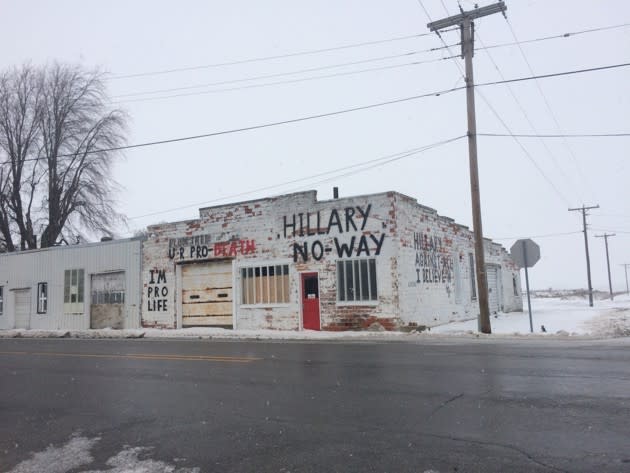
One idea is to pay for less-educated workers to move to places that are booming, as Henry Olsen has argued in The National Interest. Since successful metropolitan areas have higher wages for everybody, not just the college-educated workers, there’s reason to think that people who are struggling in small towns would be better off in big cities. Yet there’s something unsettling about pushing people to move from their homes, where they have family and deep connections. What’s more, as more and more people move to cities, it gets more expensive to live there, as the examples of San Francisco and New York City make clear. That’s a big hurdle for people who might consider moving to find better jobs.
Another idea is to encourage more people in depressed areas to seek out a college education. Surprisingly, although the demand for college-educated workers has grown in the last two decades, the supply has slowed, as the economists Larry Katz and Claudia Goldin point out. The biggest issue is the cost, of course: Tuition at public colleges and universities has nearly quadrupled since 1980 in real terms. Yet it’s likely that if more people get college educations in struggling towns, they’ll leave for the cities, where the jobs are.
Focusing on one type of industry could be a successful strategy; Warsaw, Indiana, a relatively small town in the northern part of the state, is the orthopedic capital of America, with dozens of orthopedic device companies small and large located there and a bustling economy as a result. Elkhart, Indiana is the epicenter of the recreational vehicle industry, and manufacturers and suppliers are located there, creating good jobs when the economy is doing well. Cities and towns may be able to convince a cluster of a certain type of companies to locate there, and reverse their decline. “Every place has to look at its comparative advantage, and find a niche,” Ross DeVol, the chief research officer at the Milken Institute, told me.
Still, it’s going to be much more difficult for the Connersvilles of the world to find a path forward than it will be for cities like Indianapolis. That’s partly because in today’s economy, people like Dan Dark have many more options than people like Ashley Gabbert do. The president has pledged to bring the jobs back to the Connersvilles of the world. He may manage in a few lucky areas, but it’s unrealistic to think he can pull this off across the country. That doesn’t mean anyone should give up on America’s struggling regions, which are losing jobs and population, and whose residents are going to have a harder time succeeding in today’s economy. But what will help them is far from clear.
Read more from The Atlantic:
What Trump's Executive Order on Immigration Does—and Doesn't Do
Trump Fires Acting Attorney General for Defying Order on Muslims
This article was originally published on The Atlantic.
